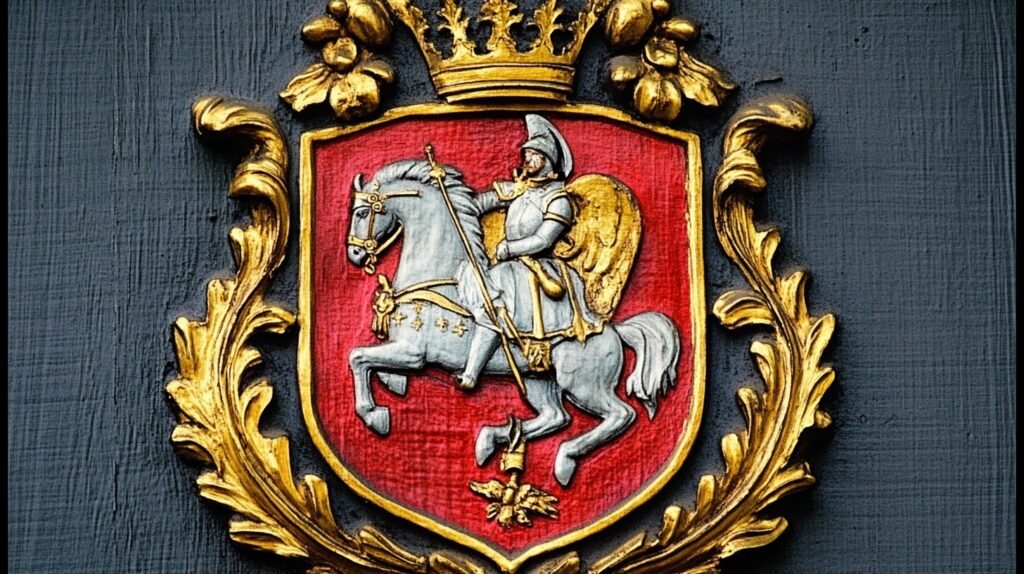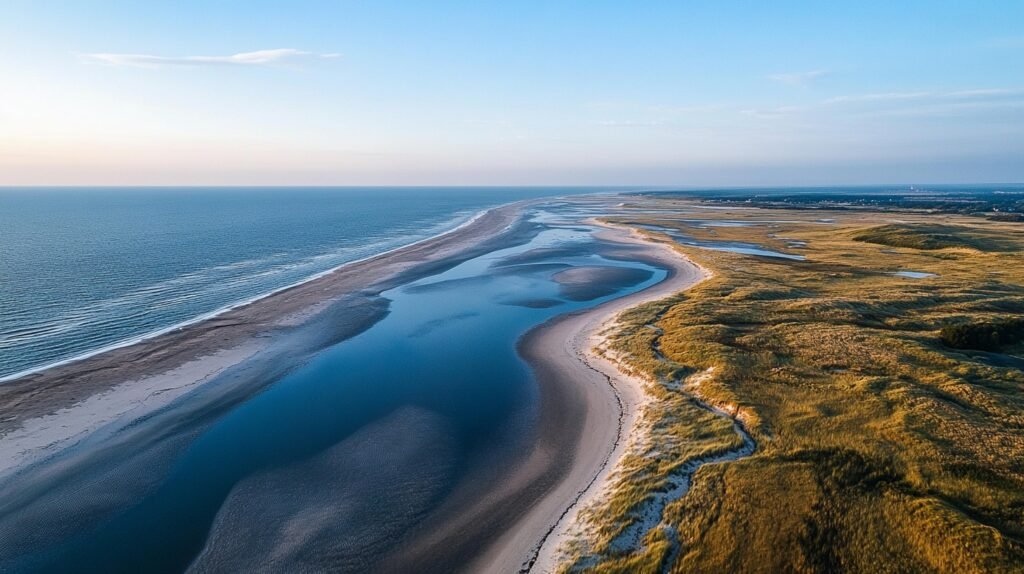
Coat of Arms of the Dithmarschen Kreis
- Historical Background: After losing its independence in 1559, Dithmarschen was divided into Norderdithmarschen and Süderdithmarschen. The region initially used the Virgin Mary and Saint Oswald as symbols in their seals.
- Introduction of the Rider Motif: Following the military defeat in 1559, the motif of an armored rider on horseback appeared in the coats of arms of the three territorial lords. This rider was initially unpopular in Dithmarschen as it symbolized the defeat by the Holstein nobility.
- Adoption and Popularity: By the end of the 18th century, the rider motif was adopted in the seals of both parts of Dithmarschen. It became popular among the population in the 19th century and was informally used as the regional coat of arms.
- Official Adoption: In 1934, the rider replaced the eagle that had been used in the official seals of the districts since 1867. After World War II, both districts reintroduced the rider motif as their coat of arms with the approval of the British occupation authorities.
- Modern Coat of Arms: The current coat of arms, adopted in 1971, features a golden-armored rider on a silver horse with a golden saddle and blue saddlecloth, wielding a silver sword. This design was officially approved and created by W. H. Lippert from Brunsbüttel.
- Symbolism: The rider symbolizes the historical territorial changes and the region’s resilience. The coat of arms reflects the merger of Norderdithmarschen and Süderdithmarschen into a single district in 1970.
Dithmarschen: The Historical Perspective
Dithmarschen, a district in Schleswig-Holstein, Germany, is a region with a rich and distinctive history shaped by its coastal location along the North Sea, bordered by the Elbe and Eider rivers and the Kiel Canal. Its story begins in prehistoric times, with archaeological evidence of settlement dating back to the Middle and Late Paleolithic periods, particularly in the Geest areas. By the 1st century CE, the marshlands along the coast were inhabited, though rising storm surges necessitated the construction of artificial dwelling mounds called “Wurten” starting around 50 CE. After a period of abandonment in the 3rd and 4th centuries, resettlement resumed in the 7th century, and by the 12th century, cooperative groups known as “Geschlechter” began constructing dikes to reclaim marshland from the sea, a testament to the region’s enduring struggle against nature.
Historically, Dithmarschen stands out for its period as a quasi-independent peasant republic, a rarity in medieval Europe. From the 13th century until 1559, it operated within the Holy Roman Empire and was part of the Hanseatic League, though it was never fully free from feudal oversight. Its autonomy stemmed from lax enforcement by overlords like the Archbishops of Bremen, allowing a unique form of self-governance to emerge, exemplified by the “Council of the 48,” a body of prominent local families. A defining moment came in 1500 with the Battle of Hemmingstedt, where Dithmarscher peasants, led by Wulf Isebrand, defeated a Danish-Schleswig-Holstein army by flooding the marshes, drowning the invaders in a tactical triumph of local ingenuity over noble might. This victory secured decades of peace, but internal strife during the Reformation and external pressures ended its independence in 1559, when a coalition led by Johann Rantzau conquered the region, dividing it among Danish rulers. After shifting hands through Danish and Prussian control, Dithmarschen was unified in 1970 into a single district with Heide as its capital.
The City of Heide
Heide, the district capital of Dithmarschen, embodies the region’s historical and cultural heart. Its name, meaning “heath” in German, reflects its origins in the 15th century when four villages united to build a church on open heathland, a site that became a central meeting point by 1447. During Dithmarschen’s time as a peasant republic, Heide grew in prominence, eventually overtaking Meldorf as the political center. Granted town status in the 19th century, Heide today has a population of around 22,000 and is known for its expansive market square—the largest unbuilt-upon market square in Germany at 4.7 hectares. Originally a gathering place, it now serves as a parking lot and hosts events like car-free Sundays, blending practicality with community spirit.
Heide’s cultural significance is tied to figures like Klaus Groth, a 19th-century poet born there, whose works in Low German elevated the dialect’s literary status. The Klaus-Groth-Museum preserves his legacy, while the St. Jürgen Church, dating to the 15th century with a striking Renaissance tower added in 1724, reflects the town’s historical evolution. Heide also hosts modern institutions like the Fachhochschule Westküste, a polytechnic with 800 students studying fields such as economics and tourism management, signaling its role as an educational hub.
The Regional Economy
Dithmarschen’s economy historically revolved around agriculture, particularly cabbage cultivation, earning it the nickname “Germany’s cabbage capital.” The arrival of the railway in 1878 spurred this sector, enabling the export of crops like sauerkraut (produced for external markets despite not being a local staple) and supporting dairy farming with Holstein cattle. Today, agriculture remains vital, with products like the Dithmarscher Gans (goose) marketed to tourists, though the eastern Geest areas focus more on dairy and fodder crops.
The 20th century brought diversification. The Mittelplate oil field, offshore since the 1980s, produces about 2 million tons annually—over half of Germany’s oil output—while the Hemmingstedt refinery processes 4 million tons of crude yearly. Industrial growth peaked mid-century with firms like CONDEA and Bayer settling in, though some have since downsized or closed. Wind energy has also taken root, with numerous turbines dotting the landscape, though local resistance highlights tensions between economic development and environmental preservation. Tourism, however, is a growing pillar, leveraging the region’s natural assets and contributing significantly to local revenue alongside agriculture and energy.

The Seaside and Tourism
Dithmarschen’s North Sea coast, including the UNESCO-listed Wadden Sea National Park, is its tourism crown jewel. The district boasts about 10 kilometers of green beaches, with Büsum offering an artificial sandy shore that draws the bulk of visitors—756,630 overnight stays in 2003 alone, far outpacing Friedrichskoog’s 75,654. The Wadden Sea, with its unique tidal flats, attracts nature lovers for walks on the seabed, while seaside resorts like Büsum and Friedrichskoog cater to families and cyclists. The region’s flat terrain and vast skies enhance its appeal, though tourism has slightly declined in recent years, less so than on Schleswig-Holstein’s Baltic coast.
Cultural attractions complement the natural draw: the Museum am Meer in Büsum explores fishing and tourism history, while flight tours from Heide-Büsum’s airfield offer aerial views of the coast. Events like Heide’s Winter World or Market Beach add seasonal flair. Economically, tourism benefits locals through job creation and demand for regional goods, though debates over wind farms reflect concerns about preserving the landscape that draws visitors. With its blend of history, nature, and modern amenities, Dithmarschen remains a cherished destination on Germany’s North Sea frontier.
Top 3 – Ditmarschen
- Meldorfer Dom (Meldorf Cathedral)
In the town of Meldorf, this 13th-century brick church—officially St. Johannis—is the district’s Gothic jewel. It’s not a true cathedral, but locals call it “Dom” for its size and swagger. The exterior’s got flying buttresses and a tower you can climb for a view over the flatlands and dikes. Inside, medieval frescoes splash color across the vaults, and the organ’s a beast—over 4,000 pipes, one of Germany’s oldest still playable. It’s a slice of history with a farmer’s pride, not fancy but solid as the land around it. - Wadden Sea National Park (Nationalpark Wattenmeer)
Dithmarschen’s western edge hugs this UNESCO-listed wonder, a tidal flatland stretching to the horizon. It’s alive with seals, crabs, and birds—think oystercatchers and migrating geese. Büsum’s a good base: grab a boat tour to see seal colonies or walk the mudflats (Wattwandern) at low tide, squishing through the muck to spots like the Trischen bird sanctuary. The sea’s moods rule here—wild and gray one day, calm the next. It’s not postcard-pretty; it’s raw and restless, and that’s the draw. - Brunsbüttel Locks
At Dithmarschen’s southern end, where the Elbe meets the Kiel Canal, these massive locks are an engineering flex. Built in the late 19th century, they’re among the world’s busiest, shuffling ships between river and canal—think freighters dwarfing the landscape. You can watch from viewing platforms as gates groan and water shifts, or check the small museum for the nuts and bolts of it. It’s industrial, sure, but there’s a strange beauty in the scale and rhythm, with the Elbe’s muddy flow stretching wide.
Bonus Tip – An Under the Radar Destination: Friedrichskoog
Friedrichskoog sits on Dithmarschen’s North Sea coast, a speck of a place overshadowed by Büsum’s bustle. It’s a working fishing village with a harbor where shrimp boats bob, and the air smells of salt and diesel. The real pull is the seal station—orphaned pups are nursed back to health here before release, and you can watch them flop around in pools. The Wadden Sea’s tidal flats stretch out front, perfect for a muddy walk if you time the tides right. It’s not polished—think practical boots over tourist gloss—but that’s its gritty appeal. Late summer’s prime, when the seals are active and the skies are clear.